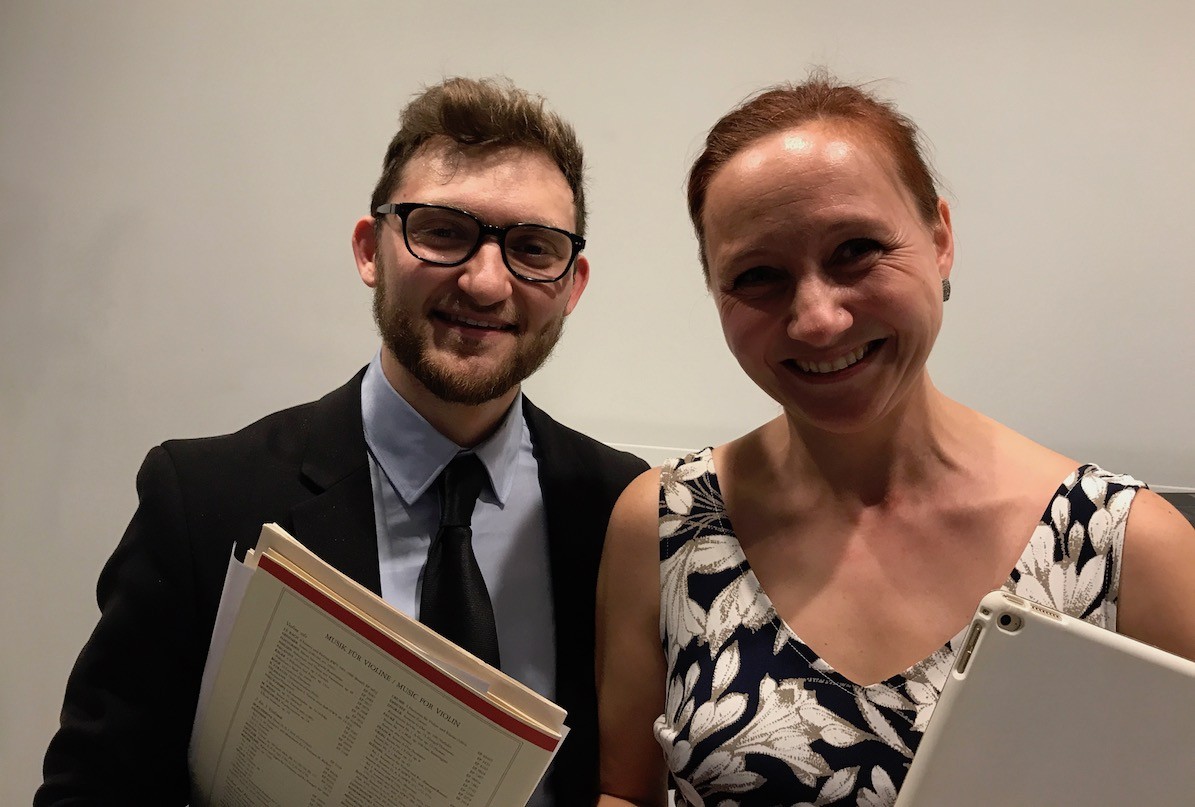Like a teenager who couldn’t wait to tell her friends about her adventure, William Shaub’s violin took off in a breathless story that ran all over the place, telling everything it knows, while Kathryn’s Gawne’s viola provided a tether, getting double-stopped words in here and there, in the first movement of Mozart’s 1783 “Duo No. 1 in G Major,” K. 423, at the Knoxville Museum of Art, Wednesday night.
So began the second of the Knoxville Symphony Orchestra’s Concertmater Series, with concertmaster William Shaub inviting four of his musician friends: violist, Kathryn Gawne; violinists, Gordon Tsai, Edward Pulgar and Zofia Glaushauser; and keyboardist, Kevin Class, to join him for an evening of music that was sensational and dazzling at moments and thoroughly satisfying throughout.
In the second movement of Mozart’s “duo,” Shaub’s violin slowed down enough to listen to the very interesting story Gawne’s viola, itself, had to tell.
In the third movement, realizing it was an equal exchange of narratives, the two had quite a lively conversation.
The “Duo” was the first of two Mozart wrote to complete a set of six duos begun by Michael Haydn, who had become too ill to complete the set for his boss, Archbishop Colloredo. Supposedly, the whole group was to be passed off as Haydn’s work. But Mozart loved the viola as much as he loved the violin. He regarded the two instruments as equals.
Michael Haydn, as well as his brother, Joseph Haydn, favored the violin, using the viola as accompaniment. In 18th century music, that was pretty much the lot of the viola before Mozart gave the instrument new status.
Violinist Gordon Tsai and keyboardist Kevin Class, playing an electronic keyboard set in harpsichord mode, joined Shaub for the next music on the program: C.P.E. Bach’s “Trio Sonata for Two Violins and Continuo in A Minor,” H.572, written in 1735.
Instrumentation during the Bach family’s time wasn’t as specific as later composers determined. The music of C.P.E., the second surviving son of Johann Sebastian Bach, could be played by a flute, instead of one of the violins and a double bass playing the continuo part, instead of the harpsichord or clavichord, the predecessor of the modern piano.
C.P.E.’s “Trio” was darker, more melancholic, than Mozart’s “Duo” had been. Superbly played by all three musicians, the two violins spent the first movement reassuring each other, while the harpsichord provided a foundation that supported them.
In the second movement, there was a stronger sense of determination, setting out with marching rhythms that kept up until the end of the piece.
Next, violinist Edward Pulgar, KSO principal second violinist, joined Shaub to play the second movement, marked “Largo ma non tanto,” from the “Concerto for Two Violins in D Minor,” BWV 1043, written by C.P.E.’s father, J.S. Bach, during the years 1717-1723. The entire concerto will be performed by Pulgar and Shaub on the next KSO Chamber Orchestra Concert at the Bijou Theatre on Feb. 4.
A strong vocal sense characterized the two stories being told with grace and dignity. One could hear moments that inspired Edward Elgar’s early 20th century “Pomp and Circumstance Marches.” There were also suggestions of Johann Pachelbel’s 1680 “Canon in D” that Bach had surely heard and tucked away for some later use.
However, the show-stopper of the concert was contemporary composer Kendall Briggs’ “Duo Concertante for Two Violins,” sensationally played by violinists Glaushauser and Shaub. It earned them a well-deserved standing ovation and more than a few whistles.
Briggs, currently a professor at the Juilliard School, in a thoroughly original piece, put the two violins through a workout that begins with very icy ideas reminiscent of the slipping and skittering on the frozen pond in the “Winter” section of Vivaldi’s “Four Seasons.” There are glimpses of Copland’s “Rodeo,” all mixed with the kind of virtuosity demanded to play the music of Fritz Kreisler. Also to be heard were minimalist marching patterns in the 2nd violin with little squeals and squeaks in the 1st violin.
The second movement was kind of dreamy, beginning with a solo by Shaub’s violin that was picked up by Glaushauser, both georgeously played. There were also prayer-like suggestions of Barber’s “Adagio for Strings.”
The third movement was a rush of notes and accents that reminded one of the rushing water racing downstream in Bedrich Smetana’s “Moldau.”
But this piece is much more than a collection of fragments. It’s a first-rate composition played brilliantly by two gifted violinists.
Bravo!
The concert will be repeated tonight at 7 at the Knoxville Museum of Art, 1050 World’s Fair Park Drive downtown. Any remaining tickets are $25 and may be purchased by calling the KSO ticket office at 865-523-1178.

